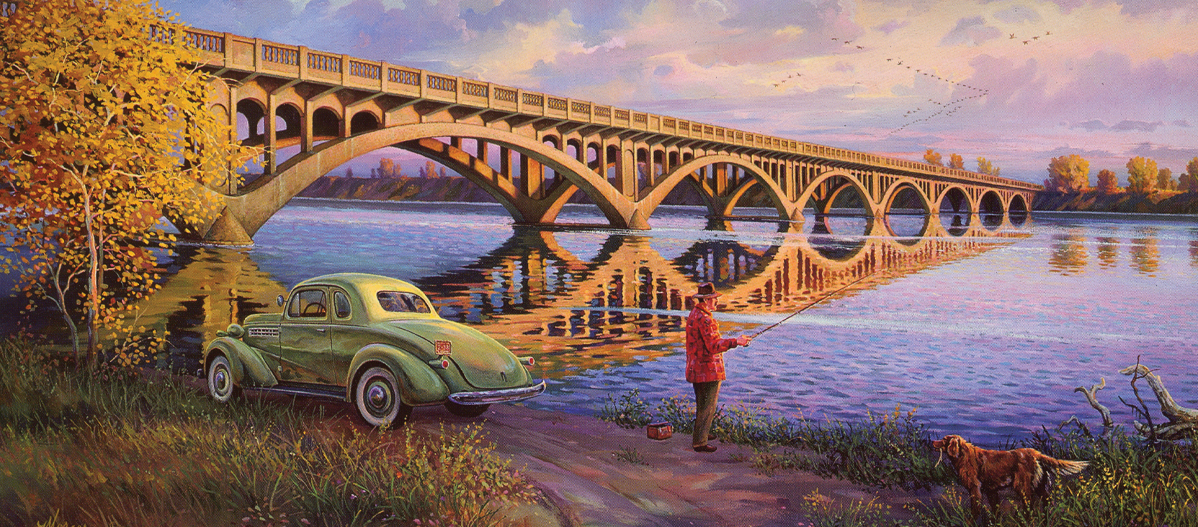By SUZANNE WARING
Bridges over rivers are built to provide safe passage for residents and to augment commerce, but they can be beautiful too.
In Great Falls, bridges are important because people live and work on both sides of the Missouri River.
In 1918, the people of Great Falls needed a bridge that connected the Black Eagle community as well as outlying rural towns and farms north of Great Falls to the town proper. Voters approved $224,000 for the construction of the bridge.
It wasn’t quite enough. They needed additional funds to build access to the bridge on both the north and south ends.
Great Falls resident and architect George H. Shanley, who had designed as many as 40 prominent buildings in Great Falls, received the nod to design what is now called the Tenth Street Bridge. He, working with structural engineer Ralph Adams of Spokane, designed the longest open-spandrel, ribbed-arch bridge in Montana.
They used the newest construction methods to build the bridge.
Earlier in 1908 and several miles downstream, concrete for the Rainbow Dam had been hauled to its destination via wheelbarrows. But just 10 years later, a new railroad trestle enabled handcars to transport mixed concrete to wooden forms for the bridge’s cast-in-place arches.
Once completed, the bridge was not only functional, but beautiful to behold.
A December 1920 Great Falls Tribune article called the new bridge “an imposing structure of sweeping arches, mighty abutments, giant girders” that was a “carved ornament rising above the water.” It served the people of Great Falls for 70 years, until it was replaced by the new Ninth Street Bridge, built in the mid-90s.
Having become redundant, the Tenth Street Bridge was slated for demolition, until a group of preservationists, spearheaded by Arlyne Reichert, 94, a community activist who had served as a delegate during the 1972 Constitutional Convention, sought to save the iconic bridge.
With just six days to spare, they were able to divert the $400,000 the Montana Department of Transportation had allocated to demolish the bridge. Since then, Preservation Cascade has raised over a million dollars to repair the bridge to serve as a pedestrian passageway, among other uses.
It hasn’t always been easy.
“They call me the ‘Bridge Lady’,” but in reality a ‘Bridge Army’ from this community and beyond worked hard to restore the bridge,” said Reichert.
When the Tenth Street Bridge was about to be demolished, a world-renowned, historic-bridge engineer, the late Abba Lichtenstein, flew to Great Falls. He personally spent days inspecting the bridge and determined that it was unique and definitely worth preserving.
Once Preservation Cascade received word the bridge was sound, they worked to restore it to its original glory.
It was listed on the National Register of Historic Places in 1996, and a grant from the prestigious Save America’s Treasures Program enabled the group to employ talented local artisans to create a model for the remaining restoration of the bridge by reconstructing one of the bridge’s spans at the north end. Abandoned utility lines were safely removed and salvaged for copper and metal.
A grant from the Montana Cultural Trust enabled the group to purchase benches and planters for the completed model arch of the bridge.
A tunnel was burrowed through the bulkhead, to integrate the bridge with Great Falls’ flagship River’s Edge Trail.
A competitive grant from the Community Transportation Enhancement Program provided for the illumination of blue lighting of the bridge at night.
In a coffee table book by National Geographic, titled Saving America’s Treasures, the bridge’s arches are pictured and described as “skipping across the water like a flat stone flung by a small boy.”
The Tenth Street Bridge preservation project has received honors from the National Trust for Historic Preservation, the National Geographic Society, the state of Montana, the Cascade County Historical Society, the Montana Contractors Association, and the Society of Industrial Archeology.
The article in Saving America’s Treasures concludes, “It’s just like what Joni Mitchell says in the song, ‘Big Yellow Taxi’: ‘You don’t know what you’ve got ‘til it’s gone.’ Happily, the people of Great Falls woke up in time, and they’ve still got it.”
And they want to share it.
To recognize the centennial of the completion of the bridge, Preservation Cascade is planning a celebration on August 20. The agenda for the celebration will depend on the status of the Coronavirus.
Watch for the latest information about this August centennial celebration on the bridge at Preservation Cascade’s Facebook page. MSN









